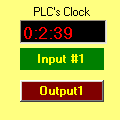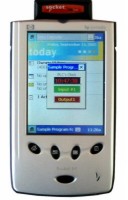import PLCmon.*;
import java.awt.*;
import java.applet.*;
public class TestApplet extends Applet
{
String URLString = "127.0.0.1:9080"; // a localhost
connection
String username = "samples";
String password = "";
int [] DM = new int[4000]; // place holder for the Data Memory DM[1] to
DM[4000]
ConnectTLServer ctlsvr;
Color darkGreen = new java.awt.Color(0,128,0);
Color darkRed = new java.awt.Color(128,0,0);
public void init()
{
//{{INIT_CONTROLS
setLayout(null);
setSize(120,120);
panel1.setLayout(null);
add(panel1);
panel1.setBackground(new
java.awt.Color(255,255,128));
panel1.setBounds(0,0,120,120);
RTC.setEditable(false);
RTC.setText("Hello");
panel1.add(RTC);
RTC.setBackground(java.awt.Color.black);
RTC.setForeground(java.awt.Color.red);
RTC.setFont(new Font("Dialog",
Font.BOLD, 16));
RTC.setBounds(20,20,87,24);
clockLabel.setText("PLC\'s Clock");
clockLabel.setAlignment(java.awt.Label.CENTER);
panel1.add(clockLabel);
clockLabel.setBounds(20,0,84,24);
output1Button.setLabel("Output1");
panel1.add(output1Button);
output1Button.setBackground(new
java.awt.Color(128,0,0));
output1Button.setForeground(java.awt.Color.yellow);
output1Button.setFont(new
Font("Dialog", Font.BOLD, 12));
output1Button.setBounds(20,80,84,22);
input1Label.setText("Input #1");
input1Label.setAlignment(java.awt.Label.CENTER);
panel1.add(input1Label);
input1Label.setBackground(new
java.awt.Color(0,128,0));
input1Label.setForeground(java.awt.Color.yellow);
input1Label.setFont(new
Font("Dialog", Font.BOLD, 12));
input1Label.setBounds(20,48,84,22);
//}}
ctlsvr = new
ConnectTLServer(URLString, username, password);
MonitorThread mt = new MonitorThread();
mt.start();
//{{REGISTER_LISTENERS
SymMouse aSymMouse = new SymMouse();
output1Button.addMouseListener(aSymMouse);
//}}
}
//{{DECLARE_CONTROLS
java.awt.Panel panel1 = new java.awt.Panel();
java.awt.TextField RTC = new java.awt.TextField();
java.awt.Label clockLabel = new java.awt.Label();
java.awt.Button output1Button = new java.awt.Button();
java.awt.Label input1Label = new java.awt.Label();
//}}
class MonitorThread extends Thread {
private Action monAction[] = new Action[10]; //
Don't make these monAction[] variable public
public void run() { // to avoid writing
action[] variables in other threds
while (true) { // run
forever (until program exits)
readRTC(); // add the list of actions you wish to monitor here
readIO();
try {
Thread.sleep(200); // update every 0.2 second
} catch (Exception e){}
}
}
void readIO() { // Read the logic state of the
inputs and outputs
monAction[0] = new Action(1,ActionConstant.READSINGLE,ActionConstant.INPUT,1,0); // Read
INPUT[1]
monAction[1] = new
Action(1,ActionConstant.READSINGLE,ActionConstant.OUTPUT,1,0); // Read OUTPUT[1]
try {
ctlsvr.commAction(monAction, 2); // Execute the two READ actions defined above
if ((monAction[0].value & 0x0001)!=0) { // Test bit 0 of 16-bit variable INPUT[1]
input1Label.setBackground(Color.green); // it is ON, light up the label in GREEN
}
else {
input1Label.setBackground(darkGreen); // it is OFF, dim the label as dark green.
}
if ((monAction[1].value & 0x0001)!=0) { // Test bit 0 of 16-bit variable OUTPUT[1]
output1Button.setBackground(Color.red); // it is ON, light up the label in GREEN
}
else {
output1Button.setBackground(darkRed); // it is OFF, dim the label as dark green.
}
}
catch (Exception e) {
RTC.setText(e.toString()); // show the error message
System.out.println(e);
}
}
public void readRTC() { // Read the read time
clock: Hours, Minutes and Seconds.
// the returned value for READSINGLE is contained in the integer variable
"value".
monAction[0] = new Action(1,ActionConstant.READSINGLE,ActionConstant.TIME ,1,0); // Read
Hour
monAction[1] = new
Action(1,ActionConstant.READSINGLE,ActionConstant.TIME, 2,0); // Read Minute
monAction[2] = new
Action(1,ActionConstant.READSINGLE,ActionConstant.TIME, 3,0); // Read Second
try {
ctlsvr.commAction(monAction, 3); // Execute 3 actions defined above
String RTCvalue = monAction[0].value +":"+ monAction[1].value+":"+
monAction[2].value;
RTC.setText(RTCvalue);
}
catch (Exception e) {
RTC.setText(e.toString()); // show the error message
System.out.println(e);
}
}
}
class SymMouse extends java.awt.event.MouseAdapter
{
public void
mouseReleased(java.awt.event.MouseEvent event)
{
Object object =
event.getSource();
if (object ==
output1Button)
output1Button_MouseReleased(event);
}
public void
mousePressed(java.awt.event.MouseEvent event)
{
Object object =
event.getSource();
if (object ==
output1Button)
output1Button_MousePressed(event);
}
}
void output1Button_MousePressed(java.awt.event.MouseEvent event) {
Action writeAction[] = new Action[10];
// to do: code goes
here.
writeAction[0] =
new Action(1,ActionConstant.READSINGLE,ActionConstant.OUTPUT ,1,0); // Read OUTPUT[1]
try {
ctlsvr.commAction(writeAction, 1); // Execute 1 action defined above
writeAction[0].actionType = ActionConstant.WRITESINGLE; // change to WRITESINGLE OUTPUT
writeAction[0].value ^=
0x0001; // Toggle OUTPUT[1] bit 0
ctlsvr.commAction(writeAction, 1); // Execute the action;
}
catch (Exception e) {
RTC.setText(e.toString()); // show the error message
System.out.println(e);
}
}
void output1Button_MouseReleased(java.awt.event.MouseEvent event)
{
// to do: code goes here.
}
}
|

